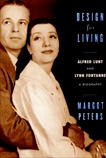
Design for Living: Alfred Lunt and Lynn Fontanne |
|
|---|---|
| Authors: | Peters, Margot |
| Publisher: | Knopf Doubleday Publishing Group |
| BISAC/Subject: | BIO005000, HIS036080, PER011000 |
| ISBN: | 9780307425515, Related ISBNs: 0307425517, 0375411178, 9780307425515, 9780375411175 |
| Classification: | Non-Fiction |
| Number of pages: | 416, |
| Audience: | General/trade |
Synopsis: From the much-admired biographer of Charlotte Brontë, Mrs. Patrick Campbell, and the Barrymores (“Margot Peters is surely now . . . our foremost historian of stage make-believe”—Leon Edel), a new biography of the most famous English-speaking acting team of the twentieth century.
Individually, they were recognized as extraordinary actors, each one a star celebrated, imitated, sought after. Together, they were legend. The Lunts. A name to conjure with. Alfred Lunt and Lynn Fontanne worked together so imaginatively, so seamlessly onstage that they seemed to fuse into one person. Offstage, they brawled so famously and raucously over every detail of every performance that they inspired the musical Kiss Me, Kate. At home on Broadway, in London’s West End, touring the United States and Great Britain, and even playing “the foxhole circuit” of World War II, the Lunts stunned, moved, and mystified audiences for more than four decades. They were considered to be a rarefied taste, but when they toured Texas in the 1930s, the audience threw cowboy hats onto the stage.
Their private life was equally fascinating, as unusual as the one they led in public. Friends like the critic Alexander Woollcott (whom Edna Ferber once described as “the little New Jersey Nero who thinks his pinafore is a toga”), Noël Coward, Laurette Taylor, and Sidney Greenstreet received lifelong loyalty and hospitality. Ten Chimneys, their country home in Genesee Depot, Wisconsin, “is to performers what the Vatican is to Catholics,” Carol Channing once said. “The Lunts are where we all spring from.”
In this new biography, Margot Peters catches the magic of Lunt and Fontanne—their period, their work, their intimacy and its contradictions—with candor, delicacy, intelligence, and wit. She writes about their personal and creative choices as deftly as she captures their world, from their meeting (backstage, naturally)—when Fontanne was a young actress in the first flush of stardom and Lunt a lanky midwesterner who came in the stage door, bowed to her elaborately, lost his balance, and fell down the stairs—and the early days when an unknown and very hungry Noël Coward lived in a swank hotel in a room the size of a closet and cadged meals at their table to the telegram the famous couple once sent to a movie mogul, turning down a studio contract worth a fortune (“We can be bought, my dear Mr. Laemmle, but we can’t be bored”).
We follow the Lunts through triumphs in plays such as The Guardsman, The Taming of the Shrew, and Design for Living; through friendships and feuds; through the intricate way they worked with such playwrights and directors as S. N. Behrman, Robert Sherwood, Giraudoux, Dürrenmatt, Peter Brook, and with each other.
Margot Peters captures the gallantry of two remarkably gifted people who lived for their art and for each other. Alfred Lunt and Lynn Fontanne were once described as an “amazing duet of intelligence and gaiety.” Margot Peters re-creates the fun and the fireworks.
Individually, they were recognized as extraordinary actors, each one a star celebrated, imitated, sought after. Together, they were legend. The Lunts. A name to conjure with. Alfred Lunt and Lynn Fontanne worked together so imaginatively, so seamlessly onstage that they seemed to fuse into one person. Offstage, they brawled so famously and raucously over every detail of every performance that they inspired the musical Kiss Me, Kate. At home on Broadway, in London’s West End, touring the United States and Great Britain, and even playing “the foxhole circuit” of World War II, the Lunts stunned, moved, and mystified audiences for more than four decades. They were considered to be a rarefied taste, but when they toured Texas in the 1930s, the audience threw cowboy hats onto the stage.
Their private life was equally fascinating, as unusual as the one they led in public. Friends like the critic Alexander Woollcott (whom Edna Ferber once described as “the little New Jersey Nero who thinks his pinafore is a toga”), Noël Coward, Laurette Taylor, and Sidney Greenstreet received lifelong loyalty and hospitality. Ten Chimneys, their country home in Genesee Depot, Wisconsin, “is to performers what the Vatican is to Catholics,” Carol Channing once said. “The Lunts are where we all spring from.”
In this new biography, Margot Peters catches the magic of Lunt and Fontanne—their period, their work, their intimacy and its contradictions—with candor, delicacy, intelligence, and wit. She writes about their personal and creative choices as deftly as she captures their world, from their meeting (backstage, naturally)—when Fontanne was a young actress in the first flush of stardom and Lunt a lanky midwesterner who came in the stage door, bowed to her elaborately, lost his balance, and fell down the stairs—and the early days when an unknown and very hungry Noël Coward lived in a swank hotel in a room the size of a closet and cadged meals at their table to the telegram the famous couple once sent to a movie mogul, turning down a studio contract worth a fortune (“We can be bought, my dear Mr. Laemmle, but we can’t be bored”).
We follow the Lunts through triumphs in plays such as The Guardsman, The Taming of the Shrew, and Design for Living; through friendships and feuds; through the intricate way they worked with such playwrights and directors as S. N. Behrman, Robert Sherwood, Giraudoux, Dürrenmatt, Peter Brook, and with each other.
Margot Peters captures the gallantry of two remarkably gifted people who lived for their art and for each other. Alfred Lunt and Lynn Fontanne were once described as an “amazing duet of intelligence and gaiety.” Margot Peters re-creates the fun and the fireworks.
LightSail includes up to 6,000 high interest, LexileⓇ aligned book titles with every student subscription. Other titles are available for individual purchase.
SUPPORT GROWING READERS

Immediately Engage Students
Simple intuitive design has classrooms reading within minutes.

Exponentially Grow Reading Time
Students love the LightSail experience and naturally spend more time reading.

Accelerate Literacy Development
Students reading 25 minutes a day on LightSail are seeing 2+ years of Lexile growth in a single year.
LightSail Education is a comprehensive LexileⓇ and standards-aligned, literacy platform and digital e-book library. Including multimodal learning functionality and featuring books from leading publishers, LightSail holistically assesses and nurtures each student on their reading and writing-to-learn journey, throughout elementary, middle, and high school.
*LightSail offers a 2,000 or a 6,000 title bundle with its student subscriptions. Other titles are available for individual purchase.



